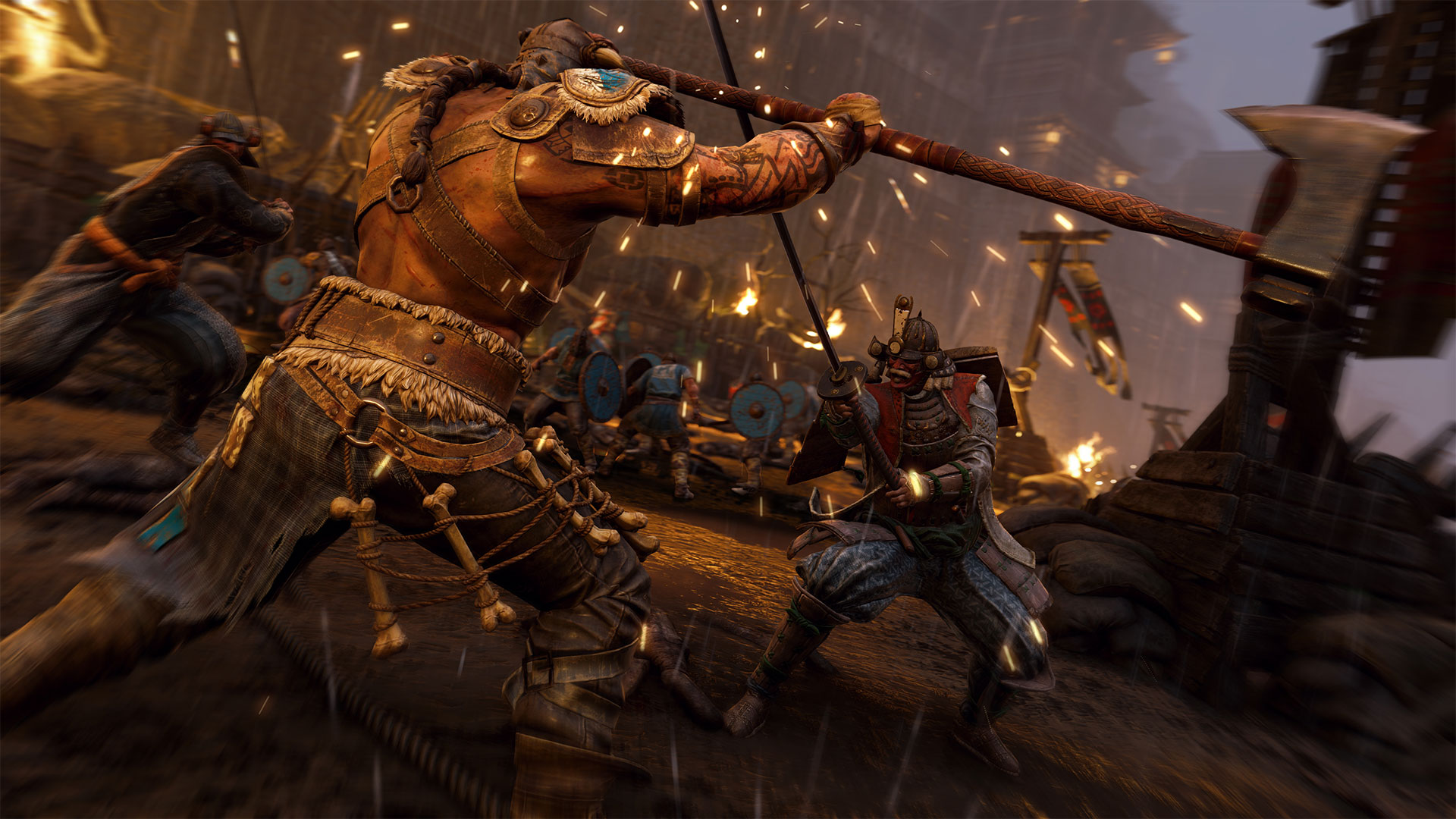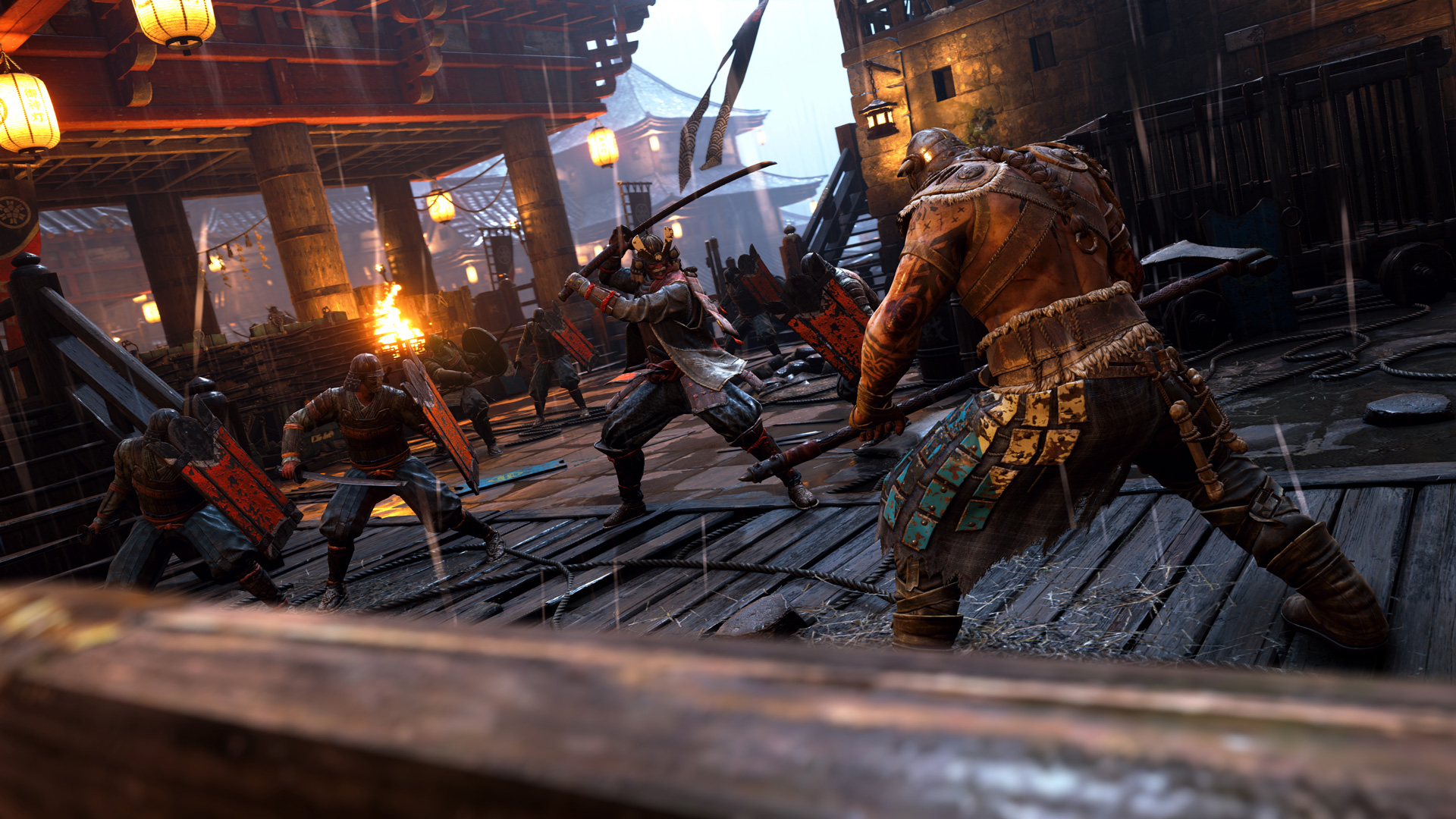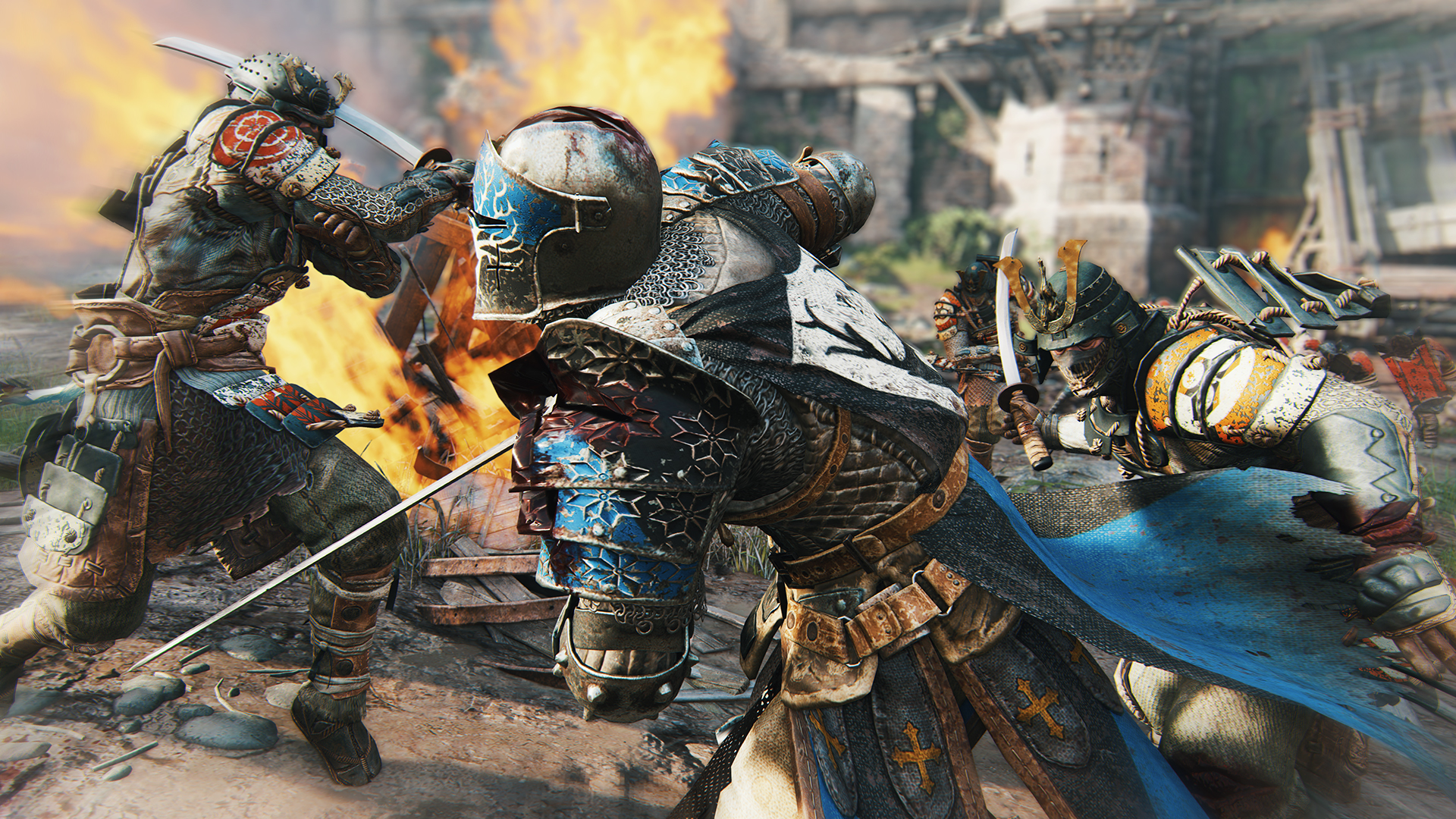Meet For Honor: the game with a life of its own that its creator had to relearn how to play
Inspirational German Longsword

For Honor is one of those rare games that doesn't fit neatly into a single genre.
On the face of it, it's a hack-and-slash in the same vein as Dynasty Warriors; a game about roaming a battlefield, killing crowds of minor enemies before facing off against generals in an opposing army.
But to call it a hack-and-slash feels reductive. When you switch to fighting generals the game's entire focus changes, and it gains a complexity that sits somewhere between a fighting game and Dark Souls.
Parries, counters and feints are the order of the day here in fights that are as much about psychology as they are about reaction speeds. It can be a dizzying experience, and one that can be tough to get your head around given how different For Honor is compared to similar games that have come before it.
We sat down with the game's creative director, Jason Vandenberghe, to discuss the game's origins, the community's response, and the odd sensation of getting beaten at your own game.
For Honor feels like a pretty unique multiplayer game. What genre do you refer to it as, and could you talk about the inspiration for the game?
Jason Vandenberghe: With the genre question I really hope that you guys can solve that problem for me. It’s a fusion right? Some guy called it a ‘battler’, I call it a ‘shooter with swords’, because it captures the scope of the content. But I don’t know, the audience will tell us.
Sign up for breaking news, reviews, opinion, top tech deals, and more.
Where it came from - so, this has been a 15-year odyssey, this is my bucket-list game. What happened was my wife and I took a course in German long-sword, which is this new rediscovered form of european martial arts, and then I was walking home one day and wondered what would happen if I took these stances and I applied them to the right-stick, and the controller configuration kind of popped into my head.
I got really excited about it and I started pitching it, and I got “No” for 10 years. Finally I pitched it at Ubisoft Montreal... they said "Yes", and here we are.
What do you think changed in those 10 years? Is it just that your pitched got more refined, or do you think hardcore hack-and-slash games have grown in popularity?
JV: I think both things happened. I had the idea prior to the Lord of the Rings movies, Game of Thrones didn’t exist at the time, and it was a different world.
Also I got better at pitching, definitely. I had started with this high-tech, technical “I have this controller idea” concept, but by the time I pitched it to Montreal my pitch had become, “I want to feel the way I feel when I pick up a weapon.”
Rather than ‘how’ it was more about the ‘what’. So I got better at that, but in the intervening fifteen years we’ve taken over, ‘the geeks’ have taken over the world, and what was once niche is now mainstream. It’s really fun to be a part of that.

The core of the game is these different stances which allow you to parry, so how did you go about building the game up from that base level?
JV: We started with that core idea about matching stances [Editor’s note: In For Honor you ‘match’ your opponent's stance to block incoming attacks]. I had come in with that idea already, and that was built in, and then we prototyped the shit out of it, and we made a couple of hundred prototypes in the first 18 months.
We had this ‘follow the fun, fail faster’ approach to developing the game. We had a small team, and when we got the go [ahead] from Ubisoft we started iterating. We would have one or two play sessions every day with new code, and we tried everything.
We built a bunch of stuff and then took the best of it and moved on with it.
By the time we hit full production, that game that you’re playing right now, we’ve been playing that game for four years. We had that game with stick figures in a grey-box environment in the first twelve months or so of development.
It was really exciting because we all knew this was already fun, and there were no graphics.
Having played it for so long yourselves, and now after it’s had its closed Beta, did anything about how people were playing the game surprise you?
JV: Normally when you go in as a game developer you know, “I’ve been playing this game for five years, I’m pretty good at it.”
You expect to show up and kick people’s ass for a while, but I remember the first day of our first alpha I was at work during the day, so I got online six hours after they’d flipped the switch.
I get online and I start playing and everyone’s parrying all the time. People are playing two to three times faster than I expected to play. The stuff that we expected to be really high-end skill stuff had already become the baseline, everyone had just accepted it, and there were all these new strategies that had appeared out of nowhere. That first night I had to relearn how to play my own game.
It was amazing... because they were playing it right, they were playing it better, and I learned a lot.
Now really what we’re doing is we’ve been adding more heroes and increasing complexity and that’s turned out to work really well.
What I love is to see how deeply people seem to understand the way that the game was intended to be played. Already there’s just a lot of people out there who’ve done what I’d hoped they would do which was apply the philosophies of real fighting, which is to say these concepts of initiative and distance and range and timing and all that stuff to what we’ve done and discovering that that works. That you can approach it from a Book of Five Rings angle. Warrior philisophies work in For Honor and it’s wonderful.

Feints have become a massive part of the For Honor experience. Was that intentional?
JV: We put feints in deliberately, knowing that the whole game is built around a mind-game where you’re trying to figure out your opponent. It’s a huge part of the experience for people who are playing that way, but you can also just ignore that and respond to what people are doing and play in a different way.
If you don’t have feints in your fighting system you end up with people getting stuck and you can’t lead each other forward. It ends up feeling like these dead-zones in the possibility matrix for these expert players.
Without feints you basically can predict what someone is doing based on where their stance is, where you think they are, you can say ‘oh well then clearly you’re doing this’ and a feint is a way of saying ‘oh I’m doing this’ but actually you’re not.
So even if people aren’t using them, the fact that they’re still there still puts people on the back foot?
JV: Exactly, because you can it creates an option-branch. When I see that animation begin, if I’m a really high-skilled player, then in the back of my mind I’m thinking it could be a feint.
For expert fighting play to work there has to be a certain amount of guesswork in place. The highest order of skill in any warrior conflict is out-guessing your opponent.

There’s been a lot of discussion around dedicated servers vs P2P. Can you talk through the decision there?
JV: One thing that is not entirely clear to people is that we don’t actually have a traditional peer to peer architecture. We have a new type of architecture that, while it’s sort of based on a peer to peer philosophy, is actually there in order for us to do this game with eight players active simultaneously and then these two hundred AI running at the same time.
We were thinking about what to call it, but it isn’t actually traditional peer to peer.
A lot of the complaints that I’m seeing online, not all of them but a lot of them, are actually just lag issues that have to do with normal network states.
That said, the game is built on that framework because without that framework there wouldn’t be a game. We wouldn’t be running the way that we are right now. I wish I could go into more detail.
At this point, it seems to be working the way that we anticipated. I’m not terribly concerned about the problem right now, but we’re going to continue to look at the needs of the player base as we move forward.
We’re going to be like Rainbow Six: Siege and The Division. We’re highly focussed on extending the game post-launch and the survival afterwards. We flip the switch day one, we assess the way that it’s all working, and then we make our decisions accordingly.
So we really appreciate the feedback from people, and I know people are highly motivated to give us their opinion about stuff, and that’s great. We’ll see what happens in the future.

I think there’s often a sense within the community to read something off a spec sheet and then decide based on that whether something is good or bad, but then the implementation of that spec is often the far more important aspect of it. It sounds like your implementation of P2P ultimately is one that you’re happy with, even if on the sheet it technically says P2P.
JV: Yeah, we run on a thing called ‘the simulation’. The way that our network system is built is that it’s built around everything being 100% fair. So what you’re seeing is what I’m seeing at the same time, there’s no visual advantage in the game.
There’s no host advantage?
JV: There’s no host advantage. This is the part that is not well understood because our technology has not been used in the wild before on other games. We’ve been using it all along, but it’s not something the audience is familiar with.
In our peer to peer solution it’s not really peer to peer, it’s based on that.
There was this moment that was really important. Six or eight months into development I had this moment where these engineers came to me and said, “So, you want to do eight players running over a network and you wan to do that with two hundred AI, over a normal internet connection? This is your pitch?”
I said, “Yes.”
They say, “That’s impossible. I don’t know if you understand how networks work designer boy but that can’t be done.”
Fortunately I work with these incredibly bright bulbs...and they come back a couple of months later with this thing called a simulation and they took a bunch of white papers for Siggraph which they assembled it into this new way of doing networking code, but when communicating it as a peer to peer model the problems with the other implementations kind of scare people, which is perfectly reasonable.
So we’ll just see moving forward how it goes, and if there are actual problems then we’ll reassess and see what we need to do.
So you’re going to be very reactive?
JV: Always.

Finally, there’s almost so much talk about framerate in the community. On PC it’s completely unlocked and on consoles it’s locked to 30. Can you talk through that decision-making process?
JV: The decision around framerate is always a difficult one to make it any project, and the decision that we were faced with came down to content: What game are we trying to build?
We’re trying to build a game that does eight fully-functional action-adventure heroes in a group of two hundred AI. It was a significant hurdle, and so from the very beginning we did a bunch of tests to see what the impact was going to be one way or the other.
We’re pretty happy with the framerate being where it is. It plays really well, and the thing is, because of the way that our simulation works with no host advantage, the gameplay doesn’t hinge on that micro-difference for the majority of players. The game doesn’t make or break itself around that moment.
I would love to be in a situation where we could be in the best of all possible worlds, but at the end of the day we needed to make sure that the game was solid and always successfully hitting its locked framerate with no drops. The only way we could do that was at the framerate that we’re at.
- Check out our guide to the best gaming laptops.

Jon Porter is the ex-Home Technology Writer for TechRadar. He has also previously written for Practical Photoshop, Trusted Reviews, Inside Higher Ed, Al Bawaba, Gizmodo UK, Genetic Literacy Project, Via Satellite, Real Homes and Plant Services Magazine, and you can now find him writing for The Verge.